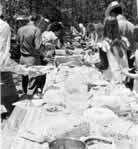 |
Volume I, No. 1, Fall 1973 |
Advantages & Disadvantages
OF A ONE-ROOM COUNTRY SCHOOL
Advantages
STUDENTS:
1. Students learned to work independently without the teacher standing over them.
2. They learned to be self-sufficient.
3. Older students learned to take responsibility with younger children.
4. Children could listen to older classes and learn from them. This allowed bright students to participate in upper classes, and slower students to work on their level without any feelings of being backward.
5. There was plenty of time to get lessons done in class.
6. Older and younger students could play together without being ridiculed or told, "You're too little."
7. Children accepted one another more for what they were, not what they thought they ought to be because of their size, age or grade level.
8. Children learned to be adaptable. They usually adjust very well in larger schools. A large percentage are honor students.
9. There was more freedom on the playground for children to run or play creatively in small or large groups as they wish.
TEACHERS:
1. There was freedom for teachers to develop their own programs, schedules, and lessons.
2. The schedule was flexible. If students were greatly benefitting by some activity, recess could wait, or be prolonged if the ball game got exciting.
3. Teacher and students ran the school to fit their needs, interest and available activities. 4. The location was isolated without interruptions.
5. The teachers could initiate long term projects and activities requiring longer than stated period lengths.
6. Teachers played with the children at recess.
COMMUNITY:
1. There was a closeness of the teacher to students and their families.
2. There was almost a family-like relationship of older and younger children working and playing together.
3. The community had an intimate feeling of pride in their own school. The patrons of the district showed their great interest in the school and its activities by everyone attending functions. When children are transported to larger schools, rural parents sometimes feel they no longer have a place in their school; some are not as interested in its activities and do not stress attendance. Therefore, school may lose some of its importance.
4. There were many social functions or treats possible for the whole community in rural schools, like pie suppers, last day of school activities, Christmas programs and dinners.
Disadvantages
STUDENTS:
1. Students often wasted time while the teacher was listening to all the other classes.
2. Students sometimes were distracted by other classes rather than studying their own lessons.
3. Because of necessity of combining upper grades, it caused some students to have to take 6th grade work before 5th, and 8th before 7th. 4. The amount learned may have suffered if children were taught by older students too often.
5. There was often not enough money for adequate supplies, books, equipment and library facilities.
6. There were not too many students of the same age to pick friends from. If a boy didn't like to play ball, for instance, there probably wouldn't be anyone but younger children to play with.
BITTERSWEET staff joins Dry and Dusty patrons at dinner
TEACHERS: The teacher was everything. If poor, everything about the school suffered.
1. Districts often couldn't pay teachers enough. The money was based on local personal and
property tax and daily average attendance. Districts were usually poor.
2. Many teachers wouldn't teach under these conditions as it was physically harder, required more preparation, and gave the teacher total responsibility. Modern teachers did not want this isolation, having no contacts with other teachers, no help in emergencies, or with discipline.
3. In many cases the quality of teachers was low. Teachers who couldn't teach any place else were often hired because teachers were hard to find.
4. Schools didn't require teachers with degrees. Teachers were allowed to teach with sixty hours college credit if they passed the county teachers examination.
5. All teachers are weak someplace. With only one teacher the weakness was passed on through the children.
6. No one teacher can teach all subjects that are needed. Schools were especially weak in art, music and physical education.
7. Teachers specialize in subjects and grade levels in their preparation and training. Rural schools had all grades and all subjects. Colleges no longer train teachers for what is needed in a one-room school.
8. Teachers needed excellent organization, control and understanding for the different problems a rural school posed.
9. There was no off-hour or relief for the teacher. He was on duty from the first child arriving to the last one leaving.
10. The teacher couldn't watch everything that went on. If he was not a good organizer and disciplinarian, there was chaos in class.
11. There were no guidelines or lesson plans to work from.
COMMUNITY:
1. Students did not get the advantage of a larger community, and the more varied background of a larger school.
2. There was no trained supervision to insure to the patrons of the district that their children got a proper education.
Courtesy of Bob Wright
[13]
Copyright © 1981 BITTERSWEET, INC.
Next Article | Table of Contents | Other Issues


